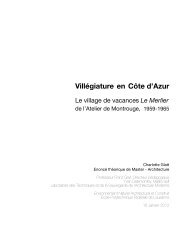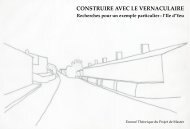(Re)branding the Flon identity: A Swiss Youth Embassy_Flon ... - EPFL
(Re)branding the Flon identity: A Swiss Youth Embassy_Flon ... - EPFL
(Re)branding the Flon identity: A Swiss Youth Embassy_Flon ... - EPFL
Create successful ePaper yourself
Turn your PDF publications into a flip-book with our unique Google optimized e-Paper software.
SoHo, NYC<br />
SoHo, <strong>the</strong> name itself, comes from its geographical situation which New York has called, “SOuth of HOuston<br />
Street”. In <strong>the</strong> colonial times, this district was originally residential, eventually becoming a very elegant<br />
place to live, attracting even larger commercial enterprises and creating a boom in urban development.<br />
After <strong>the</strong> civil war, however, a faster pace of live moved in, leaving way to <strong>the</strong> industrial and commercial era,<br />
full of import/export houses, trucking companies, wholesale houses, and such industrial era structures giving<br />
it <strong>the</strong> nickname of <strong>the</strong> “Cast Iron district”.<br />
In <strong>the</strong> mid 1900’s, <strong>the</strong> city of New York published a report declaring <strong>the</strong> area of SoHo a underutilized “comercial<br />
wastleland”, and adopted plans to run connections to <strong>the</strong> Lower Manhattan Expressway right through<br />
<strong>the</strong> district, which would, in effect, drive merchants and artists out of <strong>the</strong> area. This area had become up to<br />
that time, an area popular to artists of <strong>the</strong> time due to <strong>the</strong> buildings that offered large, open spaces ideal for<br />
studio work that were affordable to rent. Strong opposition emerged against <strong>the</strong> highway plan, and thanks<br />
to a movement in <strong>the</strong> late 1960’s, <strong>the</strong> proposal was rejected.<br />
The 1960’s was also a time in SoHo that, thanks to artists such as Frank Stella and Richard Serra with <strong>the</strong>ir<br />
bohemian art movements, brought vitality back to SoHo. Since 1971, in fact, <strong>the</strong> city adopted a zoning resolution<br />
allowing joint living-working quarters for aritists certified by <strong>the</strong> Department of Cultural Affairs. From<br />
<strong>the</strong>n on, it was legal to live in SoHo if one person in <strong>the</strong> household was a certified “artist”:<br />
By 1976, ano<strong>the</strong>r amendment increased <strong>the</strong> number of buildings that could be converted to residential use.<br />
“Almost everyone in SoHo lives <strong>the</strong>re illegally,” said Suzanne O’Keefe, executive director of <strong>the</strong> SoHo Loft<br />
Board. In 1978, <strong>the</strong> city produced comprehensive figures, in which 92% of all loft residents were illegal tenants.<br />
Yet, with <strong>the</strong> new housing regulation changes, and a certain “inobservance” of <strong>the</strong> law, SoHo began to become<br />
<strong>the</strong> chic district it is known to be today.<br />
51.
















